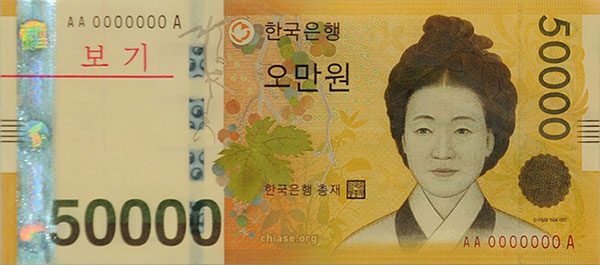The won is the currency of South Korea, consisting of 4 coins with denominations of 10 won, 50 won, 100 won, and 500 won, and 4 banknotes with denominations of 1,000 won, 5,000 won, 10,000 won, and 50,000 won.
Among these, the two banknotes of 5,000 won and 50,000 won feature a unique mark that cannot be found on any other currency in the world. The special aspect of these banknotes is the relationship between the two figures depicted on them.
They are the only two figures with a mother-son relationship. The notable figure on the 5,000 won banknote is Yi I, a prominent scholar from the Joseon period. The 50,000 won banknote features an image of his mother, Shin Saimdang.
Shin Saimdang (1504-1551) is famous in Korean history as a representative female artist of the mid-Joseon period and a mother of exceptional character who nurtured a genius scholar.

50,000 won bill.
Growing up in a matrilineal family, Shin Saimdang had the opportunity from a young age to showcase her talents in painting, embroidery, and poetry, while gaining extensive knowledge of Confucianism.
After her marriage, she adopted the pen name Saimdang (師任堂), meaning to follow the example of Lady Ren, the mother of the sage king of the Zhou Dynasty in China, King Wen.
On the front of the 50,000 won note is one of her works depicting grapevines. The back of the bill features her portrait. The image of Shin Saimdang printed on the highest denomination bill in South Korea since 2009 conveys a message from the South Korean government promoting gender equality and women’s participation in social activities.
- Successful experiment of non-radioactive nuclear fusion technology, energy sufficient to power the Earth for over 100,000 years
- The Codex Leicester by Leonardo da Vinci is the most expensive book in the world
- Strange, the longest-lasting storm in the world, has been raging for a month without ending


















































